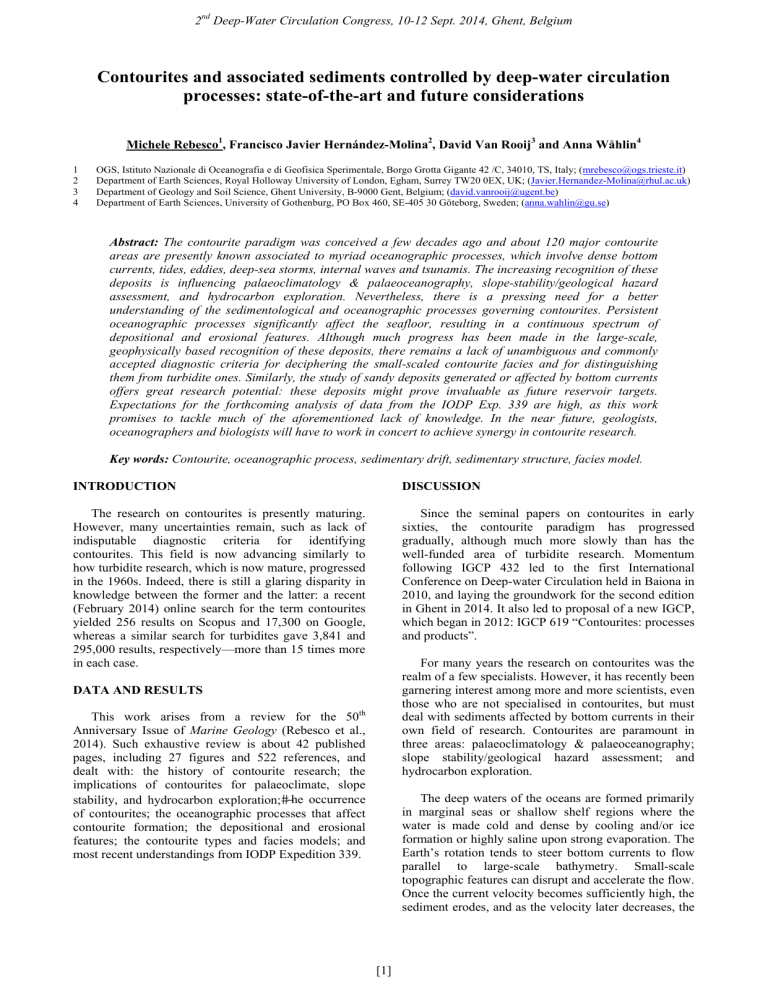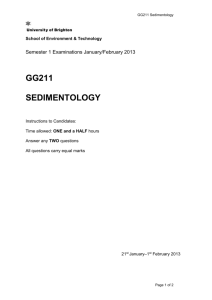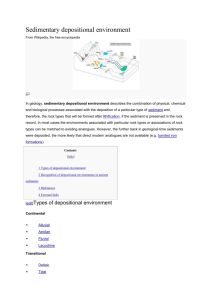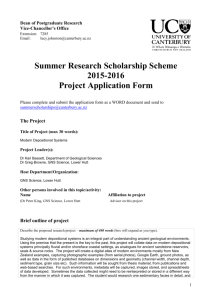Contourites and associated sediments controlled by deep-water circulation

2 nd Deep-Water Circulation Congress, 10-12 Sept. 2014, Ghent, Belgium
Contourites and associated sediments controlled by deep-water circulation processes: state-of-the-art and future considerations
Michele Rebesco 1 , Francisco Javier Hernández-Molina 2 , David Van Rooij 3 and Anna Wåhlin 4
1 OGS, Istituto Nazionale di Oceanografia e di Geofisica Sperimentale, Borgo Grotta Gigante 42 /C, 34010, TS, Italy; ( mrebesco@ogs.trieste.it
)
2 Department of Earth Sciences, Royal Holloway University of London, Egham, Surrey TW20 0EX, UK; ( Javier.Hernandez-Molina@rhul.ac.uk
)
3 Department of Geology and Soil Science, Ghent University, B-9000 Gent, Belgium; ( david.vanrooij@ugent.be
)
4 Department of Earth Sciences, University of Gothenburg, PO Box 460, SE-405 30 Göteborg, Sweden; ( anna.wahlin@gu.se
)
Abstract: The contourite paradigm was conceived a few decades ago and about 120 major contourite areas are presently known associated to myriad oceanographic processes, which involve dense bottom currents, tides, eddies, deep-sea storms, internal waves and tsunamis. The increasing recognition of these deposits is influencing palaeoclimatology & palaeoceanography, slope-stability/geological hazard assessment, and hydrocarbon exploration. Nevertheless, there is a pressing need for a better understanding of the sedimentological and oceanographic processes governing contourites. Persistent oceanographic processes significantly affect the seafloor, resulting in a continuous spectrum of depositional and erosional features. Although much progress has been made in the large-scale, geophysically based recognition of these deposits, there remains a lack of unambiguous and commonly accepted diagnostic criteria for deciphering the small-scaled contourite facies and for distinguishing them from turbidite ones. Similarly, the study of sandy deposits generated or affected by bottom currents offers great research potential: these deposits might prove invaluable as future reservoir targets.
Expectations for the forthcoming analysis of data from the IODP Exp. 339 are high, as this work promises to tackle much of the aforementioned lack of knowledge. In the near future, geologists, oceanographers and biologists will have to work in concert to achieve synergy in contourite research.
Key words: Contourite, oceanographic process, sedimentary drift, sedimentary structure, facies model.
INTRODUCTION
The research on contourites is presently maturing.
DISCUSSION
Since the seminal papers on contourites in early
However, many uncertainties remain, such as lack of indisputable diagnostic criteria for identifying contourites. This field is now advancing similarly to how turbidite research, which is now mature, progressed in the 1960s. Indeed, there is still a glaring disparity in knowledge between the former and the latter: a recent
(February 2014) online search for the term contourites yielded 256 results on Scopus and 17,300 on Google, whereas a similar search for turbidites gave 3,841 and
295,000 results, respectively—more than 15 times more in each case.
DATA AND RESULTS
This work arises from a review for the 50 th
Anniversary Issue of Marine Geology (Rebesco et al.,
2014). Such exhaustive review is about 42 published pages, including 27 figures and 522 references, and dealt with: the history of contourite research; the implications of contourites for palaeoclimate, slope stability, and hydrocarbon exploration; he occurrence of contourites; the oceanographic processes that affect contourite formation; the depositional and erosional features; the contourite types and facies models; and most recent understandings from IODP Expedition 339. sixties, the contourite paradigm has progressed gradually, although much more slowly than has the well-funded area of turbidite research. Momentum following IGCP 432 led to the first International
Conference on Deep-water Circulation held in Baiona in
2010, and laying the groundwork for the second edition in Ghent in 2014. It also led to proposal of a new IGCP, which began in 2012: IGCP 619 “Contourites: processes and products”.
For many years the research on contourites was the realm of a few specialists. However, it has recently been garnering interest among more and more scientists, even those who are not specialised in contourites, but must deal with sediments affected by bottom currents in their own field of research. Contourites are paramount in three areas: palaeoclimatology & palaeoceanography; slope stability/geological hazard assessment; and hydrocarbon exploration.
The deep waters of the oceans are formed primarily in marginal seas or shallow shelf regions where the water is made cold and dense by cooling and/or ice formation or highly saline upon strong evaporation. The
Earth’s rotation tends to steer bottom currents to flow parallel to large-scale bathymetry. Small-scale topographic features can disrupt and accelerate the flow.
Once the current velocity becomes sufficiently high, the sediment erodes, and as the velocity later decreases, the
[1]
2 nd Deep-Water Circulation Congress, 10-12 Sept. 2014, Ghent, Belgium sediment is deposited. Bottom currents are typically baroclinic: their velocity typically correlates to the strength of their density gradient. The water velocity at the seafloor can also be affected by barotropic currents, tides or intermittent processes such as giant eddies, deep sea storms, vortices, internal waves and tsunamis (Fig.
1).
FIGURE 1. 3D sketch depicting the possible oceanographic processes in deep-water environments.
An updated compilation of contourites observed in different settings and associated to either deep, intermediate or shallow water masses (and in ancient sedimentary series that are presently exposed on land) demonstrates that these deposits are ubiquitous within the oceanic basin.
Persistent bottom-current systems and associated oceanographic processes strongly affect the seafloor, ultimately conferring it with pervasive erosional and depositional features. These features can be isolated, but when alongslope processes dominate, are more likely to be part of a Contourite Depositional System (CDS) , which is an association of various drifts and related erosional features. Similarly, distinct but connected
CDS within the same water mass can be considered to be a Contourite Depositional Complex (CDC) .
However, contourites also occur interbedded with other deep-water facies types, and do not necessarily form individual sedimentary bodies. The erosional and depositional features produced by bottom currents are found at various scales: they range from small bedforms to large sediment drifts.
The creation of a definitive facies model for contourites poses major challenges. The standard contourite facies model sequence, derived from the Faro
Drift, could be considered a good model for finegrained contourite deposits and pervasive bioturbation would be a diagnostic feature of muddy/silty contourites. However, authors working in contourite settings in which sandy deposits are more common have reported that traction sedimentary structures prevail over burrowing. This controversy about the most significant diagnostic criterion for the recognition of contourite deposits might have limited significance, since different authors have probably worked in different settings. Regardless, the previous research on this issue holds two important lessons: firstly, that there is no unique facies sequence for contourites; and secondly, that traction sedimentary structures are also common within contourites.
Recently, a greater spectrum of contourite facies is being described, especially for cases in which bottom currents strongly contributed to the reworking and redistribution of turbidite fine sands (mixed turbidite/contourite depositional systems). A better understanding of the CDS and related oceanographic processes is needed to provide the optimal conditions required for proposing standard facies sequences for the variety of contourite deposits.
CONCLUSIONS
Contourite processes are not as simple as initially thought. Bottom currents can be driven by myriad oceanographic processes, most of which are not fully understood.
Given the complexity of contourite processes, the contourite nomenclature might need to be reconsidered.
There is too great a variety of deposits affected by bottom currents to be described using a single model.
Such deposits must be documented, and new facies models must be established, based on present-day marine data and outcrops.
More work is needed to understand sandy contourites, their differences with bottom-current reworked turbidite sands and their economic potential.
Integrated studies drawing on specialists from geology, oceanography and benthic biology will be essential for providing a holistic perspective.
The hitherto underestimated pervasiveness of bottom-water circulation and associated processes in shaping the seafloor and in controlling the sedimentary stacking pattern on continental margins must be reconsidered.
ACKNOWLEDGEMENTS
50 th
This contribution, extracted from a review for the
Anniversary Issue of Marine Geology , is an outcome of IGCP-619 and INQUA-1204 projects.
REFERENCES
Rebesco, M., Hernández Molina J., Van Rooij, D.,
Wåhlin, A., 2014. Contourites and associated sediments controlled by deep-water circulation processes: state-of-the-art and future considerations.
Marine Geology 352, 111-154.
[2]




